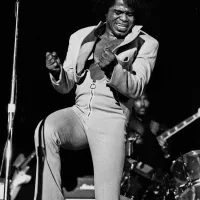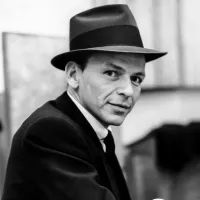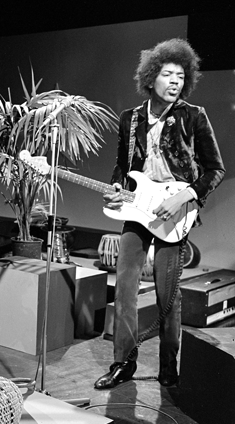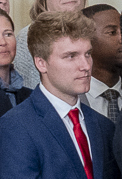Jazz originated in African-American communities of New Orleans during the late 19th and early 20th centuries, drawing from blues, ragtime, European harmony, African rhythms, spirituals, and more. It gained prominence during the 1920s Jazz Age, becoming a significant form of musical expression. Key characteristics include swing, blue notes, complex chords, call and response vocals, polyrhythms, and improvisation, highlighting its blend of tradition and innovation.
1904: Jelly Roll Morton Touring
Beginning in 1904, Afro-Creole pianist Jelly Roll Morton toured with vaudeville shows to southern cities, Chicago, and New York City.
1905: Jelly Roll Morton Composes "Jelly Roll Blues"
In 1905, Jelly Roll Morton composed "Jelly Roll Blues", which would become the first jazz arrangement in print.
1906: Buddy Bolden in New Orleans until 1906
Cornetist Buddy Bolden played in New Orleans from 1895 until 1906. His band is credited with creating the big four: the first syncopated bass drum pattern to deviate from the standard on-the-beat march.
1909: Publication of Joplin's "Solace"
In 1909, Joplin's "Solace" was published, and is generally considered to be in the habanera genre.
1912: Improvisation in mid-west jazz
Around 1912, musicians in Ohio and elsewhere in the mid-west began to improvise the melody line, though the harmony and rhythm remained unchanged.
1912: Clef Club orchestra benefit concert
In 1912, James Reese Europe's symphonic Clef Club orchestra in New York City, played a benefit concert at Carnegie Hall.
1912: Earliest Written Record of the Word Jazz
In 1912, the earliest written record of the word "jazz" appeared in an article in the Los Angeles Times, where a minor league baseball pitcher used the term "jazz ball" to describe a pitch, noting its wobbling and unpredictable nature.
1912: Publication of "Memphis Blues" sheet music
In 1912, the publication of W.C. Handy's "Memphis Blues" sheet music introduced the 12-bar blues to the world.
1914: Creole Band's International Jazz Concert
In 1914, the Creole Band with cornettist Freddie Keppard performed the first jazz concert outside the United States, at the Pantages Playhouse Theatre in Winnipeg, Canada.
1915: Publication of "Jelly Roll Blues"
In 1915, "Jelly Roll Blues" was published and became the first jazz arrangement in print, introducing more musicians to the New Orleans style.
1915: First Documented Use of Jazz in a Musical Context
In 1915, the word "jazz" was first documented in a musical context in the Chicago Daily Tribune.
November 14, 1916: First Documented Use of Jazz in a Musical Context in New Orleans
On November 14, 1916, the term "jas bands" appeared in a Times-Picayune article, marking the first documented use of the word "jazz" in a musical context in New Orleans.
1917: Storyville Shut Down
In 1917, Storyville, a red-light district in New Orleans that significantly contributed to early jazz, was shut down by the U.S. government.
1917: First Jazz Recordings
In 1917, the Original Dixieland Jass Band made the music's first recordings early in the year, and their "Livery Stable Blues" became the earliest released jazz record.
February 1918: James Reese Europe's "Hellfighters" in Europe
In February 1918, during World War I, James Reese Europe's "Hellfighters" infantry band took ragtime to Europe, then on their return recorded Dixieland standards including "Darktown Strutters' Ball".
1918: Paul Whiteman's Success
In 1918, Paul Whiteman and his orchestra became a hit in San Francisco.
1919: Original Dixieland Jazz Band Tour of Britain
In 1919, British jazz began with a tour by the Original Dixieland Jazz Band.
1919: Kid Ory's Band Plays in San Francisco and Los Angeles
In 1919, Kid Ory's Original Creole Jazz Band of musicians from New Orleans began playing in San Francisco and Los Angeles.
1919: Ragtime Dominance Until 1919
Until about 1919, ragtime was the major influence in Ohio and elsewhere in the mid-west.
1920: Start of Prohibition
In 1920, Prohibition began in the United States, banning the sale of alcoholic drinks, leading to the rise of speakeasies as venues for jazz music.
1922: Kid Ory's Band Records
In 1922, Kid Ory's Original Creole Jazz Band became the first black jazz band of New Orleans origin to make recordings.
1924: Bix Beiderbecke Forms The Wolverines
In 1924, Bix Beiderbecke formed The Wolverines.
1924: Louis Armstrong Joins Fletcher Henderson's Band
In 1924, Louis Armstrong joined the Fletcher Henderson dance band for a year as featured soloist and also in 1924, one of Armstrong's favorite "Sweet Jazz" Big bands was formed in Canada by Guy Lombardo.
1924: Premiere of Gershwin's Rhapsody in Blue
In 1924, Paul Whiteman commissioned George Gershwin's Rhapsody in Blue, which was premiered by his orchestra.
1926: Fred Elizalde Broadcasts on the BBC
In 1926, Fred Elizalde and His Cambridge Undergraduates began broadcasting on the BBC.
1927: Duke Ellington Opens at the Cotton Club
In 1927, Washington, D.C.-native Duke Ellington opened at the Cotton Club in Harlem.
1928: Earl Hines Opens at The Grand Terrace Cafe
In 1928, Earl Hines opened in The Grand Terrace Cafe in Chicago.
1933: End of Prohibition
In 1933, Prohibition in the United States ended, after having banned the sale of alcoholic drinks since 1920.
1934: Quintette du Hot Club de France Begins
In 1934, the Quintette du Hot Club de France was formed, marking the full swing of a jazz style in France that combined African-American jazz and symphonic elements. This style was also inspired by Paul Whiteman.
1937: Founding of The International Sweethearts of Rhythm
In 1937, The International Sweethearts of Rhythm were founded. They would later become the first all-female integrated band in the U.S.
1938: Benny Goodman's Jazz Concert at Carnegie Hall
In 1938, Benny Goodman's jazz concert at Carnegie Hall took place, marking the first jazz concert ever played there.
1938: Morton's Recordings for the Library of Congress
In 1938, Jelly Roll Morton made a series of recordings for the Library of Congress in which he demonstrated the difference between ragtime and jazz.
1942: World War II Impacts Jazz
In 1942, World War II created difficulties for the big-band format of swing music including conscription, shellac limitations for records, rubber shortages impacting touring, and a musicians' union recording ban.
1942: Charlie Parker's Harmonic Development
In early 1942, while performing "Cherokee" at Clark Monroe's Uptown House in New York, Charlie Parker experienced a breakthrough in harmonic development. He realized that he could use the higher intervals of a chord as a melody line and back them with appropriately related changes, leading to a new sound.
1943: "Tanga" is Composed
In 1943, "Tanga", composed by Mario Bauza and recorded by Machito and his Afro-Cubans in New York City, became the first original jazz piece overtly based in clave. It began as a spontaneous descarga with jazz solos superimposed on top.
1943: Earl Hines Band Pioneers Modern Harmonies
In 1943, Gunther Schuller heard Earl Hines' band, which included Bird, playing flatted fifth chords, modern harmonies, and Dizzy Gillespie-style runs. This band never made recordings.
1944: Commercial Recording Ban Limits Music Distribution
Between 1942 and 1944, a demand by the musicians' union for a commercial recording ban limited music distribution. The world war had already been negatively affecting the Jazz scene.
1945: The International Sweethearts of Rhythm Tour Europe with the USO
In 1945, the International Sweethearts of Rhythm, the first all-female integrated band in the U.S., toured Europe with the USO.
1947: "Manteca" is Created
In 1947, Dizzy Gillespie and Chano Pozo collaborated to produce "Manteca", the first jazz standard rhythmically based on clave. Pozo composed the guajeos of the A section and the introduction, while Gillespie wrote the bridge.
1953: Hard Bop Develops
In 1953, Hard bop began to develop as an extension of bebop music which incorporates influences from blues, rhythm and blues, and gospel, especially in saxophone and piano playing.
1954: Hard Bop Coalesces
In 1954, Hard bop coalesced. It developed partly in response to the vogue for cool jazz in the early 1950s and paralleled the rise of rhythm and blues.
1954: Miles Davis Introduces Hard Bop at Newport Jazz Festival
In 1954, Miles Davis's performance of "Walkin'" at the first Newport Jazz Festival introduced the hard bop style to the jazz world.
1955: Hard Bop Prevalent
From 1955, hard bop was prevalent within jazz for about a decade, remaining highly influential on mainstream or "straight-ahead" jazz.
1957: A Blowin' Session Album
In 1957, Coltrane, Johnny Griffin, Mobley, and Morgan all participated on the album A Blowin' Session, considered by Al Campbell to have been one of the high points of the hard bop era.
1957: Mary Lou Williams Converts to Catholicism
In 1957, Mary Lou Williams converted to Catholicism, which led her to compose three masses in the jazz idiom.
1959: Kind of Blue Album Exploration
In 1959, Miles Davis introduced the concept of modal theory to the greater jazz world with Kind of Blue, an exploration of the possibilities of modal jazz which would become the best selling jazz album of all time.
1959: "Afro Blue" is First Recorded
In 1959, Mongo Santamaria first recorded his composition "Afro Blue". It was the first jazz standard built upon a typical African three-against-two (3:2) cross-rhythm, or hemiola, beginning with the bass repeatedly playing 6 cross-beats per each measure of 8.
1959: Cal Tjader's "A Night in Tunisia" Live Recording
In 1959, on a live Cal Tjader recording of "A Night in Tunisia", pianist Vince Guaraldi soloed through the entire form over an authentic mambo.
1959: Black Orpheus film achieves popularity
In 1959, the film Black Orpheus achieved significant popularity in Latin America, which led to North American jazz musicians being exposed to the bossa nova style, later influencing a worldwide boom of the genre.
1960: John Coltrane's "Giant Steps" Composed
In 1960, John Coltrane composed "Giant Steps", a complex piece with 26 chords per 16 bars that can be played using three pentatonic scales. Coltrane studied Nicolas Slonimsky's Thesaurus of Scales and Melodic Patterns for inspiration.
1960: Coltrane Signs with Impulse! Records
In 1960, John Coltrane signed with Impulse! Records, turning it into "the house that Trane built", while championing many younger free jazz musicians.
November 1961: Coltrane at the Village Vanguard
In November 1961, Coltrane played a gig at the Village Vanguard, which resulted in the classic Chasin' the 'Trane, which DownBeat magazine panned as "anti-jazz".
1962: Dizzy Gillespie's "Night in Tunisia" Released
In 1962, Dizzy Gillespie's song "Night in Tunisia" was released, later sampled in 1988 by Gang Starr in "Words I Manifest", marking the emergence of jazz rap.
1963: John Coltrane Covers "Afro Blue"
In 1963, John Coltrane covered "Afro Blue", inverting the metric hierarchy and interpreting the tune as a 4 jazz waltz with duple cross-beats superimposed (2:3). Coltrane also expanded the harmonic structure of the song, which was originally a B♭ pentatonic blues.
1963: Getz/Gilberto album released, cementing bossa nova's popularity
In 1963, the album Getz/Gilberto was released, cementing bossa nova's popularity and leading to numerous recordings by famous jazz performers. It established the bossa nova style as a lasting influence in world music.
1964: "October Revolution in Jazz" Organized
In 1964, Bill Dixon organized the 4-day "October Revolution in Jazz" in Manhattan, the first free jazz festival.
June 1965: Ascension is Recorded
In June 1965, Coltrane and 10 other musicians recorded Ascension, a 40-minute-long piece that included adventurous solos by young avant-garde musicians and was controversial for its collective improvisation sections.
June 1965: Coltrane Recordings Evolve
In June 1965, a series of recordings with the Classic Quartet show Coltrane's playing becoming increasingly abstract. The recordings include The John Coltrane Quartet Plays, Living Space and Transition.
July 1965: New Thing at Newport Recorded
In July 1965, The John Coltrane Quartet recorded New Thing at Newport album.
September 1965: First Meditations Recorded
In September 1965, The John Coltrane Quartet recorded First Meditations album.
September 1965: Pharoah Sanders Joins Coltrane's Band
In September 1965, after recording with the quartet, Coltrane invited Pharoah Sanders to join the band. Sanders would overblow his entire solo, resulting in a constant screaming and screeching in the altissimo range of the instrument.
1965: Duke Ellington's First Sacred Concert
In 1965, Duke Ellington wrote "A Concert of Sacred Music", the first of his three Sacred Concerts, in response to contacts from Grace Cathedral in San Francisco.
1965: Joe Henderson Uses Pentatonic Lick on "African Queen"
In 1965, Joe Henderson played a minor pentatonic lick over blues changes on Horace Silver's "African Queen", demonstrating the use of the minor pentatonic scale in blues improvisation.
1965: Vince Guaraldi Releases "Jazz Mass"
In 1965, Vince Guaraldi released "Jazz Mass" on Fantasy Records.
1965: Hard Bop Remains Influential
Until 1965, hard bop was prevalent within jazz for about a decade, remaining highly influential on mainstream or "straight-ahead" jazz.
1966: Joe Masters Records "Jazz Mass"
In 1966, Joe Masters recorded "Jazz Mass" for Columbia Records, featuring a jazz ensemble, soloists, and choir using the English text of the Roman Catholic Mass.
1967: Worlds of Jazz and Rock Begin to Converge
Around 1967, the worlds of jazz and rock, previously separate, began to trade ideas and occasionally combine forces as rock became more creative and some in jazz sought new directions beyond hard bop and avant-garde.
1967: Wayne Shorter Composes "Footprints"
In 1967, Wayne Shorter composed "Footprints", the first jazz standard by a non-Latino to use an overt African 8 cross-rhythm. On the version recorded on Miles Smiles by Miles Davis, the bass switches to a 4 tresillo figure.
1968: Duke Ellington's Second Sacred Concert
In 1968, Duke Ellington wrote his Second Sacred Concert, as part of a series of sacred works prompted by contacts from Grace Cathedral in San Francisco.
1968: Mary Lou Williams Composes Mass Honoring Martin Luther King Jr.
In 1968, Mary Lou Williams composed a jazz mass to honor the recently assassinated Martin Luther King Jr.
1968: Miles Davis Inspired by Rock and Funk
In 1968, Miles Davis was inspired by James Brown, Jimi Hendrix, and Sly and the Family Stone's "Dance to the Music", influencing his shift towards rock and funk elements in his music. He discarded chord sheets during the recording of "In a Silent Way" to encourage improvisation.
1969: Miles Davis Embraces Electric Instruments with "In a Silent Way"
In 1969, Miles Davis fully embraced electric instruments with In a Silent Way, his first fusion album. This quiet, static album, heavily edited by Teo Macero, was also influential in the development of ambient music.
1969: The Tony Williams Lifetime Releases "Emergency!"
In 1969, contributors to Miles Davis's "In a Silent Way" joined Larry Young to create "Emergency!" by The Tony Williams Lifetime, one of the early acclaimed fusion albums.
1970: Williams's Emergency! Suggested New Musical Language
According to jazz writer Stuart Nicholson, in 1970, albums such as Williams's Emergency! suggested the potential of evolving into something that might eventually define itself as a wholly independent genre quite apart from the sound and conventions of anything that had gone before."
1971: Weather Report's Self-Titled Debut
In 1971, Weather Report's self-titled debut album caused a sensation in the jazz world with its unorthodox approach and pedigree members. DownBeat awarded the album Album of the Year, describing it as "music beyond category".
1972: Miles Davis's "On the Corner" and Jazz-Funk Exploration
In 1972, Miles Davis's "On the Corner" marked his foray into jazz-funk, aiming to reconnect with the young black audience who had largely forsaken jazz. The album blended rock and funk influences with Indian and Cuban rhythms, creating a multi-layered soundscape.
1973: Duke Ellington's Third Sacred Concert
In 1973, Duke Ellington wrote his Third Sacred Concert, concluding a series of sacred works prompted by contacts from Grace Cathedral in San Francisco, prior to his death in 1974.
1974: Gonzalez Brothers Join Eddie Palmieri's Salsa Group
From 1974–1976, Jerry and Andy Gonzalez were members of one of Eddie Palmieri's most experimental salsa groups, which incorporated parallel fourths and McCoy Tyner-type vamps. Salsa was the medium, but Palmieri was stretching the form in new ways.
1974: Duke Ellington's Death
In 1974, Duke Ellington died after writing three Sacred Concerts in response to contacts from Grace Cathedral in San Francisco.
1975: Mary Lou Williams' Third Mass Performed
In 1975, Mary Lou Williams' third mass, commissioned by a pontifical commission, was performed in St Patrick's Cathedral in New York City.
1975: Davis's Agharta Suggested New Musical Language
In 1975, albums such as Davis's Agharta suggested the potential of evolving into something that might eventually define itself as a wholly independent genre quite apart from the sound and conventions of anything that had gone before.
1976: Gonzalez Brothers Active in Eddie Palmieri's Salsa Group
From 1974–1976, Jerry and Andy Gonzalez were members of one of Eddie Palmieri's most experimental salsa groups, which incorporated parallel fourths and McCoy Tyner-type vamps. Salsa was the medium, but Palmieri was stretching the form in new ways.
1976: Irakere's "Chékere-son" Introduces New Style
In 1976, Irakere's "Chékere-son" introduced a "Cubanized" bebop style, differing from typical Cuban music with its bebop-flavored horn lines. The song was based on Charlie Parker's "Billie's Bounce", blending clave and bebop, which influenced the harmonic complexity of Cuban jazz and timba.
1980: Common Practice for Latin Tunes
By 1980, it had become common practice in jazz arrangements to use a Latin A section and a swung B section, with all choruses swung during solos in tunes from the jazz standard repertoire. This approach can be heard on pre-1980 recordings of various songs.
1983: Keith Jarrett Forms 'Standards Trio'
In 1983, pianist Keith Jarrett established his 'Standards Trio', which primarily performed and recorded jazz standards, while also occasionally exploring collective improvisation.
1986: John Zorn releases Spy vs. Spy and Last Exit records first album
In 1986, John Zorn released the Spy vs. Spy album, incorporating punk rock elements into free jazz. Also in 1986, Last Exit, consisting of Sonny Sharrock, Peter Brötzmann, Bill Laswell, and Ronald Shannon Jackson, recorded their first album, blending thrash and free jazz.
September 23, 1987: Jazz Declared a National Treasure by U.S. House
On September 23, 1987, the United States House of Representatives passed a bill to define jazz as a unique form of American music and a national treasure.
November 4, 1987: Jazz Declared a National Treasure by U.S. Senate
On November 4, 1987, the United States Senate passed a bill to define jazz as a unique form of American music and a national treasure, concurring with the House's decision.
1988: Emergence of Jazz Rap
In 1988, jazz rap started to develop, and Gang Starr released "Words I Manifest", sampling Dizzy Gillespie's "Night in Tunisia". Stetsasonic also released "Talkin' All That Jazz", which sampled Lonnie Liston Smith.
1989: Gang Starr's Debut LP "No More Mr. Nice Guy"
In 1989, Gang Starr released their debut LP No More Mr. Nice Guy, which sampled Charlie Parker and Ramsey Lewis, contributing to the jazz rap genre.
1990: Gang Starr's "Jazz Thing" and A Tribe Called Quest's Album Release
In 1990, Gang Starr released "Jazz Thing" which sampled Charlie Parker and Ramsey Lewis. Also, A Tribe Called Quest released People's Instinctive Travels and the Paths of Rhythm.
1991: A Tribe Called Quest Releases "The Low End Theory"
In 1991, A Tribe Called Quest released "The Low End Theory", an album that incorporated jazz influences, contributing to the jazz rap genre.
1992: Miles Davis's Doo-Bop Released Posthumously
In 1992, Miles Davis's final album, Doo-Bop, was released posthumously. This album was notable for its foundation in hip-hop beats and collaborations with producer Easy Mo Bee.
1992: Pete Rock & CL Smooth Release "Mecca and the Soul Brother"
In 1992, the rap duo Pete Rock & CL Smooth incorporated jazz influences on their debut album, Mecca and the Soul Brother.
1993: Guru's Jazzmatazz Series Begins
In 1993, Guru's Jazzmatazz series began, utilizing jazz musicians during the studio recordings.
1994: Herbie Hancock releases Dis Is da Drum
In 1994, Herbie Hancock released the album Dis Is da Drum, which reflected his absorption of hip-hop influences.
1998: Lalo Schiffrin Releases "Jazz Mass in Concert"
In 1998, Lalo Schiffrin released "Jazz Mass in Concert" on Aleph Records.
2000: "Latin Bass Figure" Terminology in Jazz Styles: History and Analysis
In 2000, Mark Gridley's Jazz Styles: History and Analysis referred to a bossa nova bass line as a "Latin bass figure," illustrating a basic understanding of Cuban and Brazilian music among jazz musicians.
2001: Ken Burns's "Jazz" Documentary Premieres
In 2001, Ken Burns's documentary Jazz premiered on PBS, reviewing the history of American jazz. The documentary faced criticism for its limited representation of non-American traditions and US developments in the late 20th century.
2013: Angelo Versace's Dissertation on Sacred Jazz
In 2013, Angelo Versace's doctoral dissertation examined the development of sacred jazz in the 1950s, noting the combination of black gospel music and jazz. Versace maintained that religious intent separates sacred from secular jazz.
2013: Versace Identifies Contemporary Sacred Jazz Exemplars
In 2013, Versace identified bassist Ike Sturm and New York composer Deanna Witkowski as contemporary exemplars of sacred and liturgical jazz.
2015: Kendrick Lamar releases To Pimp a Butterfly and Kamasi Washington releases The Epic
In 2015, Kendrick Lamar released his third studio album, To Pimp a Butterfly, featuring contemporary jazz artists and redefining jazz rap. In the same year, Kamasi Washington released his debut album, The Epic, sparking a resurgence in jazz on the internet.
2015: James Taylor Composed "The Rochester Mass"
In 2015, jazz organist James Taylor composed "The Rochester Mass" released on Cherry Red Records.
2016: Wynton Marsalis Releases "Abyssinian Mass"
In 2016, Wynton Marsalis released "Abyssinian Mass" on Blueengine Records, a recent example of sacred music performed by jazz artists. This highlights the ongoing incorporation of African-American sacred music within jazz.
2018: Will Todd Records "Jazz Missa Brevis"
In 2018, classical composer Will Todd recorded his "Jazz Missa Brevis" with a jazz ensemble, soloists, and the St Martin's Voices on a Signum Records release called "Passion Music/Jazz Missa Brevis", also released as "Mass in Blue".
March 2020: Emmet Cohen Broadcasts Performances Live From New York
Starting in March 2020, Emmet Cohen began broadcasting a series of live performances from New York, gaining popularity through social media.
Mentioned in this timeline

James Brown an iconic American singer songwriter dancer and musician...
The United States of America is a federal republic located...

Kendrick Lamar is a highly acclaimed American rapper singer songwriter...

Martin Luther King Jr was a pivotal leader in the...

Frank Sinatra nicknamed Chairman of the Board and Ol' Blue...

Jimi Hendrix was an American musician renowned for his extraordinary...
Trending
Wavy Gravy born Hugh Nanton Romney Jr is an American entertainer and peace activist He gained prominence for his role...
10 days ago Israeli Attacks in Gaza Kill Children, Violating Ceasefire Agreements: Escalating Tensions

6 days ago Cam Spencer Shines Off Bench for Grizzlies, Continuing Impressive Performance

6 months ago Julia Fox Ditches Beauty Trend, Net Worth Soars: An 'It Girl' in 2025
22 days ago DHS immigration crackdown hits Charlotte, sparking protests and local confusion.

2 months ago Tiwa Savage apologizes for Tyla's remarks, sparking online backlash and 'coloured' identity row.
Popular
Matt and Ross Duffer known as the Duffer Brothers are...

Candace Owens is an American conservative political commentator and author...
Aftyn Alyssa Behn is an American politician currently serving as...

Ilhan Omar is an American politician currently serving as the...

XXXTentacion born Jahseh Dwayne Ricardo Onfroy was a controversial yet...

Tom Cotton is an American politician and Army veteran currently...

